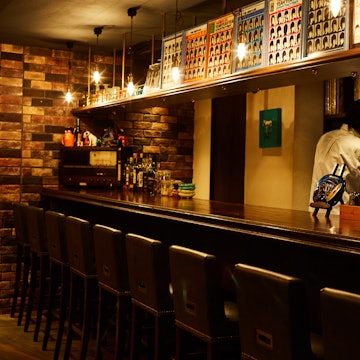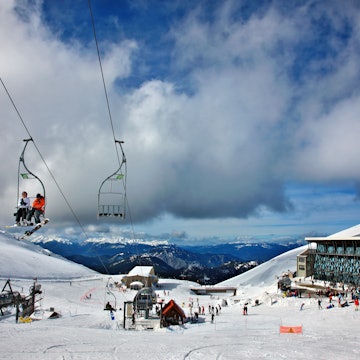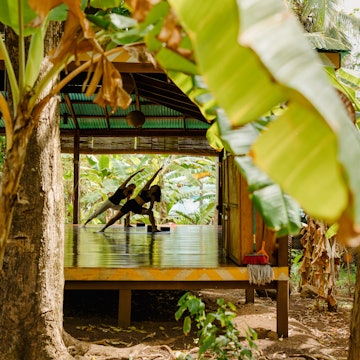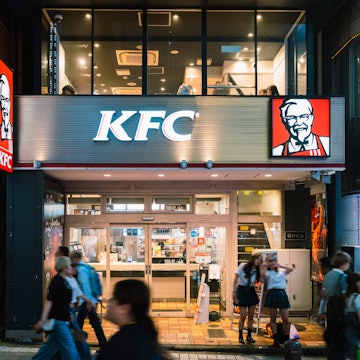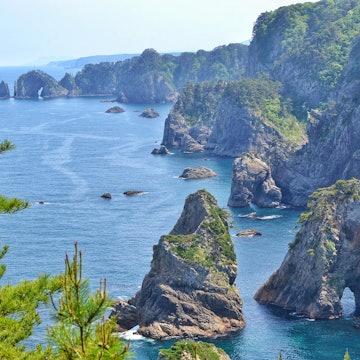

The smallest prefecture in Japan, rural Kagawa punches well above its weight when it comes to regional cuisine. Relatively unexplored by international tourists, those travelers who do venture here will find a welcoming, rich cultural heritage, stunning natural landscapes, and udon noodles that are soul-warming in every sense of the word.

Sanuki Udon
Tucked away on Shikoku – itself the smallest of the country's four main islands – Kagawa is the proud home of arguably the most famous type of udon in Japan: sanuki udon. It takes its name from the prefecture’s former name of Sanuki, and the noodles are characterized by their firm, chewy texture and thick, square shape with smooth, flat edges. They can be enjoyed in a wide variety of styles, such as in a hot broth made with locally-sourced iriko (dried sardines) or served with a cold dipping sauce. Prices are also extremely reasonable at around ¥200 (less than USD$2 or £2) a bowl.
Sanuki udon is far more than just a local dish, however. For the people of Kagawa prefecture, udon is deeply ingrained in their identity and daily life. From the local farmers who provide the ingredients, to the families running udon shops from their homes and the locals who dine there every day before work, udon is the tie that binds the community together. It’s little wonder, therefore, that they’ve adopted the nickname udon-ken – meaning udon prefecture – for themselves.

As befits an area with this moniker, there are around 700 udon shops in Kagawa, which can make it difficult to choose where to go to sample the dish. You can, of course, take a gander and wander around, to see what you find – and if there’s a queue outside a restaurant, join it! It’s a sure sign that their udon is some of the best.
To make things easier on yourself, however, consider hiring a local expert to get some insider knowledge. Udon Taxi can provide you with a specialist driver (all of whom can make udon themselves!) for an hour or two to take you to the best udon restaurants to suit your tastes, as well as telling you more about the history and culture of the dish.

To really immerse yourself in the world of udon during your visit, stay at Udon House. Billed as a ‘noodle hotel’, Udon House runs programs that aim to link visitors with the local community. These include udon-making classes with resident experts, visits to local farms, and tours of restaurants – both the big names and those that aren’t included in the guidebooks.
You may also like: Five reasons to visit Japan's Kagawa Prefecture

Other Kagawa delicacies
Although the most well-known, sanuki udon is far from Kagawa prefecture’s only culinary treasure. Another dish to look out for is shodoshima somen, a more delicate noodle made using locally-produced sesame oil and painstakingly separated by hand before being left to dry in the sun. In addition, the iriko sardines often used in sanuki udon broth can be enjoyed with rice in a meal known as iriko-meshi, whilst Shimahide shrimp rice crackers are made using shrimp caught in the nearby Seto Inland Sea.
The latter is the body of water which lies between Shikoku and two of Japan’s other main islands, Honshu and Kyushu. It has a long history as an important trade and transport route, and its shores were once the country’s main salt-producing region. Whilst some traditional salt makers still remain, these days the area is also gaining increasing popularity as a tourist destination. This is thanks to its hundreds of picturesque islands, and the beautiful tranquility of the waters in which they sit.

The depths of these same waters provide Kagawa with the rich variety of fresh, seasonal seafood that infuses its cuisine. This includes specialties such as olive hamachi – Japanese amberjack or yellowtail fish which are fed on powdered olive leaves in order to give them extra health benefits and a uniquely rich taste. The olives themselves are locally-grown on Shodoshima, Kagawa’s largest island, taking advantage of the area’s Mediterranean-style climate.
Shodoshima is also home to several traditional soy sauce breweries, some of which now open their doors to visitors. Here family-run breweries use ancient techniques and natural flavorings to craft authentic, top quality sauces. Head to Marukin Soy Sauce Museum to find out more and sample the finished products – for something a little different, try their unexpectedly tasty soy sauce ice cream. The island also has another famous soy sauce-related delicacy known as tsukudani, which is small pieces of meat, seafood, or seaweed simmered in soy sauce, and often added to rice to give it an intense kick of flavor.
You may also like: A no-sushi guide to food in Japan

Scenic delights
The beauty of Kagawa extends far beyond its foodie credentials. Much of the region is part of the Setonaikai National Park, known for its wild coastlines and intriguing islands. One of the most visually stunning spots is Chichibugahama in Mitoyo. This kilometre-long beach is covered with tide pools, which on windless days create a perfectly mirrored surface to reflect the sky, allowing for some breathtakingly magical photographs.
Back on Shodoshima, once you’ve had your fill of olives and soy sauce, take a romantic walk out along Angel Road. This golden sandbar is only visible twice a day during low tide, and couples walk it hand-in-hand in order to be granted a long and happy relationship. Another unmissable sight on the island is the Kankakei Gorge, said to be one of the three most beautiful gorges in Japan. It can be explored by ropeway or hiking trail, and is particularly striking during the autumn kouyou season when the leaves change colour to fiery reds and blazing oranges.

Cultural treasures
There are also plenty of Kagawa cultural destinations, ancient and modern, well worth a look once you’re full of noodles and fish. One of the biggest draws is Naoshima, Kagawa’s island of art. This immersive experience allows you to experience some of Japan’s best modern art simultaneously with the gorgeous natural surroundings through outdoor installations and world-class galleries.
On the spiritual side, the last 22 temples on the Shikoku 88 Temple Pilgrimage are located in Kagawa, and many are worth visiting even if you’re not planning on making the hike yourself. Zentsū-ji, with its impressive five-story pagoda, is the largest of all 88. It’s also one of the most important, as it’s said to be where Kobo Daishi – who founded the Shingon sect of Buddhism in Japan – was born.
Not far from here you’ll find Kompirasan, also known as Kotohiragu. A shrine dedicated to seafaring, it sits at the top of a gruelling 785 stone steps – perfect for burning off all that sanuki udon!
Produced by Lonely Planet for Kagawa Prefecture Government. All editorial views are those of Lonely Planet alone and reflect our policy of editorial independence and impartiality.
Get more travel inspiration, tips and exclusive offers sent straight to your inbox with our weekly newsletter. Make the most of your travel with sightseeing tours and activities from our trusted partners.







